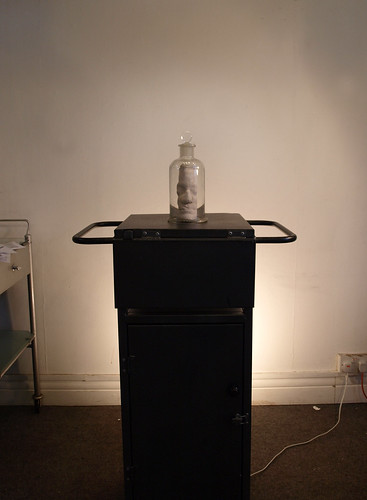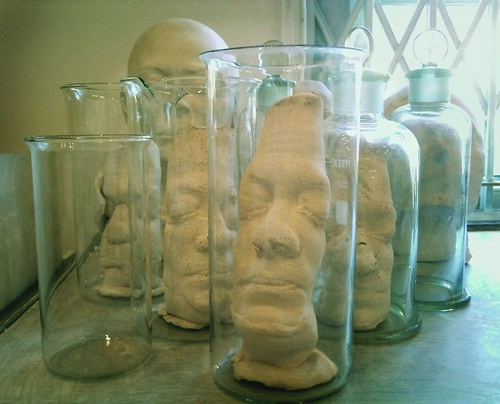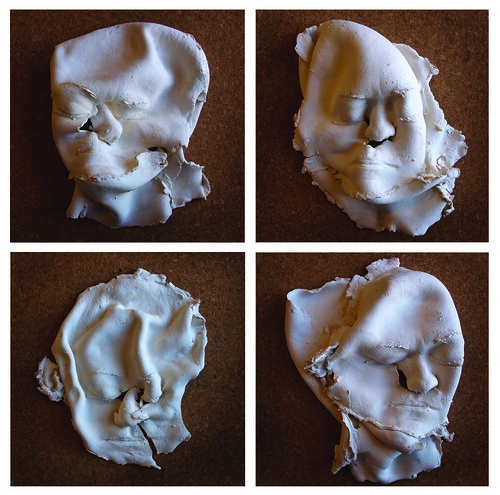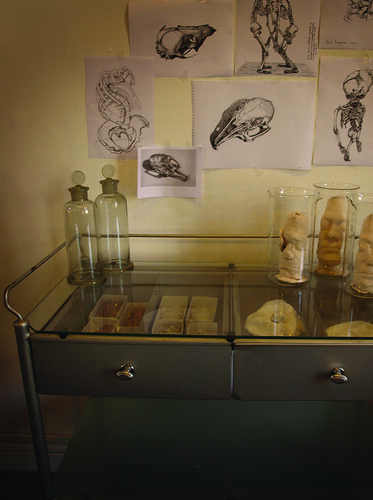What
is it that makes the objects and specimens of the medical museum so
compelling and repelling in equal quantity? What is it about the
malformations of the bottled monsters of the teratological specimen
that draws our horrified and delighted attention? Since the birth of
what is known in the west as modern medicine, the word
"monstrosities" has been used to describe physical
deformities, ‘irreducible to the "proper body" in their
singular, sometimes startling difference’ [1] These
accidents of nature suggest something other than the normal self, and
yet they are not outside our selves or nature, but recognisably part
of it. That sense of alteriety which gives such specimens their
fascination and appeal is tied to the uncanniness that is born of
strangeness within the familiar.
I
experienced this duality when, as a child, I arrived from an English
boarding school in Malaysia to find that everything I had learnt
about my 'mother country' was out of kilter. I thought that I was
English, but found that I was in fact alien, other, in a country I
considered home. Not only that, but I realised that the borders
between normality and the monstrous were rigorously delineated here
in a way which they had not been in Malaysia. There, in my Malay
mother's village, the lines between what was 'real', and normal, and
what was bizarre, uncanny, were much blurred. Monsters were all
around: in the jungle, or in the corner shop: everybody knew someone
who had too many fingers or toes – or someone whose uncle had been
eaten by a ghost, or an enormous snake. All these experiences were
equally valid. After trying to fit into the dull realism of Essex
life, I began, as an artist, to revisit some of these ideas of the
strangeness in familiarity, and at the same time began to explore the
confusion inherent in my own sense of who I was. Roy Porter suggests
that ‘our sense of self presupposes an understanding of our
bodies.' [2] There
had been a point, at school, when my interests were divided between
art and biology: so I began to work from my own fascination for the
body, and the medical collection.

My adult interest
in this material began after visiting Gunther Von Hagen’s' “Body
Worlds” exhibition in Brussels. It wasn’t, in the end, the
plastinated bodies that piqued my interest: rather it was a small
display at the end of the exhibition of pre-plastination preservation
techniques. In this darkened room there was a horrified fascination
as visitors clustered around the teratological specimens. This in
stark contrast to the rest of the exhibition where, by the end, most
people felt an ‘emotional anaesthesia’ [3] occasioned by yet another bizarrely posed body, become as bland as a
mannequin in some netherworld between science and art.
Yet his work
was inspired by the preparations of Honoré Fragonard (1732-99),
whose “Anatomised Cavalier” and dancing foetuses draw the gaze
where Von Hagen's preparations do not. Fragonard himself was
denounced as a madman for his pursuit of preservation. His ecorché
“Man with a Mandible”, with its rolling glass eyes, is both a
vision of a man horrified, and quite horrible in itself.
When I began my
research into the medical collection, there were two aesthetic
avenues of medical preparation that I was looking at: the wet
specimen, and the wax moulage. The use of the moulage came about to
serve the needs of dermatological diagnostics, as the wet preparation
did not preserve the colours of the skin well. More lifelike, the wax
allowed for casts made from living subjects, and gave a three
dimensional study which replaced the patient and did not decay.
Smaller models were often placed in glass jars like the ones used for
wet specimens – to further emphasise in the viewer a sense that
they were 'real'. Larger models warranted their own glass bier.
There
is a part-body in the Deutsches-Hygiene Museum
in Dresden of a woman giving
birth. It uses as its armature, disturbingly, the deceased woman’s
own pelvic bones. A number of disembodied surgical hands float above
the partially-dissected womb - all male, and neatly dressed at the
wrists with white cuffs and dark suit sleeves, hovering above the
anatomical Venus like cherubs around a Madonna.
These wax moulages
have a powerful effect, both when viewed individually and en masse:
the largest collection is at the Hospital of St. Louis in Paris, and
I defy anyone to remain unmoved by the ‘wall of syphilis’. All
these body parts are surreally segregated, removed from the whole so
that just the diseased part is on display, surrounded by a neat
border of fabric: mounted on a black board like a specimen, one is
not meant to imagine the whole, but focus on this intimate portion of
disease or deformity.

This
hyper-surreality of the moulage led me to experiment with casting my
own face. The fragility of the mould resulted in my not being able to
take many casts from it: however as the mould broke up, the casts
began to resemble the deformities of the moulage – in this process
I felt that I was taking the life mask through processes that
referenced the effects of congenital accident or deformity, removing
it from the body, taking it as part-feature, metonomous. I kept the
casts of my slowly collapsing face colourless, and mounted them on
coloured boards instead.
They made me
reconsider myself in terms of that childhood experience of finding
that I was an alien as much because of my skin colour as my
post-colonial upbringing. How strange to be other in the country one
thinks of as home: and an equally curious sensation, to see your own
face disembodied. At this point I began to look again at the wet
specimen, and specifically examples of heads and faces.
Wet specimens are
body parts or a whole foetus preserved in fluid such as formalin or
alcohol. They have been described as ‘objects between nature and
representation, art and science’[4] The effect of seeing these aberrations, further distorted by the
curve of the preserving jar, is truly uncanny. Freud, in his essay on
the subject, recalls an occasion where he comes face to face with his
own reflection in a train door, and momentarily mistakes it for
someone else: not only that, but someone that he found unpleasant to
look upon. This sense of something at once sinister but homely echoes
in the correlation of preservation in jars; of bodies, or of fruit.
This is particularly true of the teratological specimen. Here, the
preserving jar acts as a pseudo-womb, the little monsters within
floating placidly in the urine-coloured liquid as if awaiting the
moment of birth.

Actually,
this, while a poetic image, is not true: often the expression on
their faces (if they have one) is anything but placid, and the
illusion of the amnion is altogether ruined by the evidence of
autopsy: the lack of a brain, large stitches across their heads,
glass rods keeping them in position. In the case of the specimen
known as 'sirenome' in the Musée Fragonard, the foetus is held in
position by a cord tied, disturbingly, around its neck.
I
had this idea of toying with the purpose of the wet collection,
namely that it should preserve – I wanted to make work in which the
heads, in their different materials, decayed, changed and altered in
the sterile confinement of their container. The artist Marc Quinn
made his head out of his own blood, perhaps the ultimate act of
self-portraiture: I thought about using materials such as
clay, wax, bread, shit, or fat, and then immersing the heads in
liquids such as milk, urine, wine - even kombucha, a living liquid.
Here I wanted to reverse the notion of the liquid in the jars acting
as a preservative, and reference the familiarity of foodstuffs in the
un-homelike environs of the laboratory. In order to do this properly,
however, I first had to cast my own head.
Much
of what we are, as humans, is determined by our appearance, and much
of that, as a woman, is determined by hair. In order to truly face my
Self, I realised that I had make my head naked. And so I shaved my
head, and made my first uncomfortable discovery– that the back of
my head was quite flat. This first head-casting was a two-part mould
that involved the use of dental alginate, a pink rubbery substance
that smelled, bizarrely, of mint. The alginate broke apart while
being removed from my face and I managed to get only one cast from
this distorted mould. Interestingly, having been researching life and
death masks, this cast brought to mind a particularly famous death
mask – that of L'inconnue de la Seine.
At this point I
decided to revisit my visual research in the museum.
Interest in the
medical collection, particularly for teratological specimens,
straddles a line between science and sideshow. Early collections by
surgeons later opened to public, and these displays further blurred
borders between the gallery and the teaching museum. During my visits
to the Hunterian and Wellcome in London, and the Dupuytren and
Fragonard in Paris, I began to wonder - who is going to these
collections? Not scientists any longer, but the curious and creative
autodidact. The Mütter Museum, a noted medical museum in
Philadelphia, has daily visits from eager schoolchildren and their
teachers rather than medical professionals.
 In the Dupuytren,
the only cabinet with lights is the teratological cabinet, where the
double-headed kitten and goat nestle in jars side by side with the
thoracopagus foetuses and other monstrosities. Each small corpse
exhibits alongside its deformation a particular and individual
appearance: their little faces angry, or vacant, indifferent. The
Dupuytren also has two faces half eaten by cancers: part of their
compulsion comes from the obvious and horrible disease, but part –
for me at least – from the unique and recognisable humanity of each
face: one with soft, receding hair floating silkily in the preserving
fluid: one with dark brows and beard, and an arrogant twist to his
lips.
In the Dupuytren,
the only cabinet with lights is the teratological cabinet, where the
double-headed kitten and goat nestle in jars side by side with the
thoracopagus foetuses and other monstrosities. Each small corpse
exhibits alongside its deformation a particular and individual
appearance: their little faces angry, or vacant, indifferent. The
Dupuytren also has two faces half eaten by cancers: part of their
compulsion comes from the obvious and horrible disease, but part –
for me at least – from the unique and recognisable humanity of each
face: one with soft, receding hair floating silkily in the preserving
fluid: one with dark brows and beard, and an arrogant twist to his
lips.
Peter the Great
(1672-1725) was famously the possessor of a notable wunderkammer- after a visit to Leiden, he bought the entirety of Frederik Ruysch's collection of anatomical preparations. His
mania for specimens, among other drives, led him to execute his
wife's lover, whose head was then preserved it in a jar; though in
the interests of fairness, he did the same to his own lover. These
bottled heads were later found by his grandson's wife, who remarked
upon their youthful appearance before, sadly, having them buried.
There
is a particularly macabre head in the Mütter Museum. It is not on
general display, but is down in the cold storage of the wet room, in
a jar held upright by a simple metal bookend. It is Negroid, and for
some reason the eye has been rather brutally removed. It is cut in
half, right through the delicate, pouting lips and weak chin;
however, the particular horror and humanity that I found in this
specimen was, for me, evinced by the collection of white-headed
pimples on the colourless, sallow cheek.
Armed with a
visual cortex full of bottled horrors, I returned to the workshop
determined to try again. This time, another colleague was finally
intrigued enough by my bald head to make a three part mould, starting
with the back of my head, then my chin and neck, and finally – nose
straws and earplugs in place – my face. Word had travelled around
the college, in light of my earlier attempt, and this casting was
observed by a large group of fine art students, all happily making
notes and taking photographs of my shiny Vaselined pate. I
experienced on this occasion something strange: people were talking
to me throughout this process, up until the point at which my face
disappeared under the plaster. Suddenly, they ceased talking to
me, and began to talk about
me, like an object. I lay there, offered up for display like a
medical Venus, listening to the chatter around me, as if I were
suffering from 'locked-in' syndrome – for the first time I had the
experience of moving from person to specimen.
Apart from a brief
moment of fear when the mould was momentarily stuck to my ears, this
was a successful mould-making. The first cast I took from this mould
was made using expanded latex, which resulted in a rubbery squashy
head that I delighted in carrying around like a baby. The happily
uncanny experience of coming face to face with my own face resulted
in a number of inappropriate behaviours, such as sticking it up my
jumper so the features protruded like an alien baby about to explode
from my belly.
 Perhaps the Alien
analogy is close to the effect I was experiencing: in the film Alien
Resurrection, when Ripley enters the room full of rejected or
malformed mutants in huge jars, she sees herself, repeated; the
monstrous mother worse than the alien mother of earlier films in the
horror of their sympathetic humanity. They are her, but they are not:
they are further deformed by their failure to live up to their true
monstrosity: she is ‘haunted by (these) alternative versions’ of
herself. [5]
Perhaps the Alien
analogy is close to the effect I was experiencing: in the film Alien
Resurrection, when Ripley enters the room full of rejected or
malformed mutants in huge jars, she sees herself, repeated; the
monstrous mother worse than the alien mother of earlier films in the
horror of their sympathetic humanity. They are her, but they are not:
they are further deformed by their failure to live up to their true
monstrosity: she is ‘haunted by (these) alternative versions’ of
herself. [5]
What
interested me in my playing with the latex head was not only my
reaction to my double, but others in seeing me with my doppelgänger.
Everyone felt that seeing me, for example, kiss my own rubbery head,
was wrong and repulsive in ways that they couldn't articulate. This
is where I felt I began to tap into those primal reactions that were
evoked by the bottled babies, through a reinterpretation of both the
aesthetics of the teratological wet specimen and the facial cast or
moulage.
Eventually
I made a master mould which allowed for casting in a variety of
materials. Having been earlier inspired by the plaster life and death
masks in the Galton collection, I began to make a series of casts in
plaster. By now, I was less interested in making the heads out of the
abject materials that I had started with, after observing the
uniformity of the plaster. The blank whiteness of it in contrast to
my own skin was so 'other' in its lack of colour and featurelessness.
So taken was I by the rows of blank white plaster heads that
it seemed to me that the heads themselves
should remain inert, white and anodyne as aspirin: it was the liquid
that they were immersed in that should reference this contrast
between purity and abjection.
There
was also something of a compulsion about repetition, similar to what
I found when making multiples of my eyes or lips. The decapitation
seemed peculiarly uncanny. Having commissioned a number of
jars that were watertight and large enough to contain my head, I
built a cabinet to put them in – with lights – and proceeded to
fill each jar up to the nose with fluids – milk, wine, water and
urine.
The cabinet took on
a religious aspect as the fluids reflected the light like
stained-glass, and seemed to create a space somewhere between museum
and gallery, clinic and altar. The fluids themselves took on
religious and transformative significances: the blood of Christ, the
milk offered to Ganesh, the psychotropic reindeer urine imbibed by
the shamen of Lapland. The jar containing water remained empty of a
head, as I eventually determined this should be the 'control' jar. It
was later remarked to me that the empty jar was more disturbing than
the jars with heads in, as the absence seemed frighteningly more
uncanny by dint of its inexplicability – one could envisage, it
seemed, a head in a container that is head-sized, but the lack of
head seemed to raise a deep feeling of unease.
In
the end, the casting of my head did not result in work that was
compelling in the way that the teratological specimens or moulages
were: to my mind they evoked a different kind of horror: the
juxtaposition of clean white plaster and rotting, foul liquids had
the appearance of some sordid experiment gone awry. The work became
instead a visual exploration of the way in which the museum specimen
seems to reflect, in some measure, residues of the human: return the
gaze of the spectator to create a deeper reflection, from object to
abject, self to other, and back. Here, in the rows of heads colouring
and dissolving in unnamed liquids, the artist becomes both subject
and object.
All this serves, I
hope, to connect the contemporary concerns of science with an
unconscious atavism - a simultaneity of the pure
and the profane, the proper and the monstrous. But to my mind I have
only just begun the first step in a body of work which was inspired,
originally, by a single desire: to put my own head in a jar.
1: Jeffrey Longacre, Review of Monstrosities: Bodies and
British Romanticism, by
Paul Youngquist. College Literature, 22 September
2005, University of Tulsa.
2: Roy Porter, Flesh
in the age of Reason
London: Penguin, 2004:44
3: Taken
from the chapter 'The limits of empathy' in Linke, Uli “Touching
the
Corpse:
the unmaking of memory in the body museum” in
Anthropology Today
Vol.21
No.5, October 2005: 13-19
4: Taken
from information sheet about the AHRC Research Network "The
Culture
of Preservation", a series of workshops and
lectures at UCL run by Petra Lange-
Berndt and Mechthild Fend, London May/June 2011.
5: From
part 3 of Zizek, Slavoj
The Perverts
Guide to the Cinema filmed
by Fiennes,
Sophie. Lone Star Films, 2006
Images:
1 'Man with a Mandible, Musée Fragonard, Paris
2 'moulage' clay and wood, Lisa Temple-Cox
3 'Sironeme', drawn from specimen in Musée Fragonard, Lisa Temple-Cox
4 face cast and death mask of L'inconnu de la Seine
5 face, drawn from specimen in Musée Dupuytren, Lisa Temple-Cox
6 'face baby'
7 'Cabinet', assemblage/installation, Lisa Temple-Cox
selected bibliograpy:
Alberti,
Samuel J.M.M. Morbid Curiosities: Medical Museums in Nineteenth
Century Britain Oxford:OUP 2011
Asma,
Stephen T.
Stuffed Animals and Pickled Heads: the Culture and Evolution of
Natural History Museums Oxford:
Oxford University Press, 2001
Daston,
Lorraine and Park, Katherine Wonders
and the Order of Nature 1150-1750
New York: Zone Books 2001
Daukes,
S. H. The
Medical Museum London:
The Wellcome Foundation, 1929
Foucault,
Michel The Birth
of the Clinic London:
Routledge, 1997
Freud,
Sigmund “The
uncanny”(1919)
in Art and
Literature London:
Penguin, 1990
Knoppers,
Laura L. and Landes, Joan B. (eds)
Monstrous Bodies/political monstrosities in early modern Europe
Ithaca/London:
Cornell University Press, 2004
Kristeva,
Julia Powers of
Horror: an essay on abjection New
York: Columbia University Press, 1982
Linke,
Uli “Touching the Corpse: the unmaking of memory in the body
museum” in
Anthropology Today Vol.21
No.5, October 2005: 13-19
Porter,
Roy Flesh in the
age of Reason London:
Penguin, 2004
Sawday,
Jonathan The
Body Emblazoned London:
Routledge, 1996
Schnalke,
Thomas (Author) Spatschek, Kathy (Translator)
Diseases in Wax: The History of the Medical Moulage Quintessence
1995
Zizek,
Slavoj The
Perverts Guide to the Cinema filmed
by Fiennes, Sophie. Lone
Star Films, 2006















